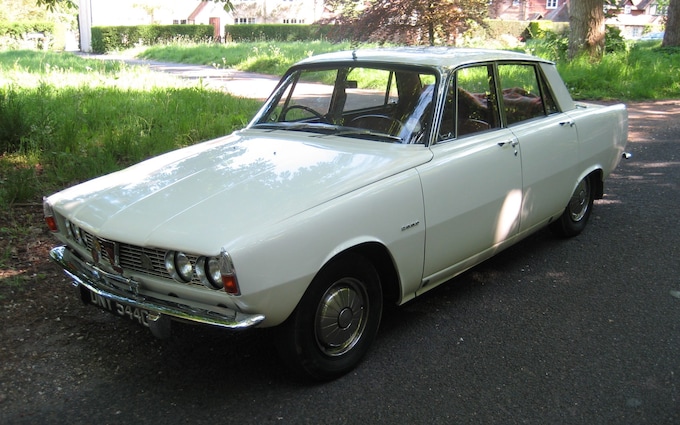
Rover 2000: the first Car of the Year at 60
The conservative British marque’s radical saloon – many wrongly thought it Italian and unattainable – was a winner from the start

When production of the Rover P6 ceased in early 1977, it had become part of the automotive establishment; the archetypal transport for bank managers, solicitors and grey-faced Detective Inspectors in TV crime shows. But on its debut in 1963, the original 2000 (the V8 came later, in 1968) forged an entirely new market sector and redefined the quintessentially British brand. Furthermore, it was the first European Car of the Year – this year’s winner is the battery-powered Jeep Avenger.
Work commenced on the P6 in September 1956, with David Bache in charge of its styling. In his view, the specification lent itself to “a simple classical form, devoid of all superfluous ornament”. Some prototypes wore badges for the fictitious Talago brand to avert curiosity when tested on the public highway. However, in 1961 the public had a preview of the future 2000’s appearance with the gas turbine-powered T4 experimental car.
The P6’s body consisted of non-stressed panels bolted to a unit frame, with power from a new 1,978cc four-cylinder overhead-camshaft engine. The specification included an all-synchromesh gearbox and disc brakes on each wheel, with the suspension marking a significant departure from Rover tradition. It consisted of front double wishbones with top links at 90 degrees to their lower counterparts and at the rear a De Dion sliding tube with fixed-length driveshafts.
The 2000’s elaborate promotion campaign included the splendid 30-minute PR film Assignment P6, narrated by James Mason sound-alike John Carson. Nick Dunning of the Rover Sports Register, the owner of the 1964 car shown here, points out: “Shooting of the picture began in 1961 and it took over a year to make, as it followed the P6’s development. There were extensive international locations, and you can even see prototypes that were sadly destroyed.”
The press launch was on 8 October 1963, with the company presenting its audience of motoring writers with boxes containing Rover 2000-branded cigarettes. The public launch took place at the London Motor Show a few days later. The P6 greatly impressed the motoring correspondent of this paper in a test headlined “Rover Revolution”. He believed the extensive development and £10 million investment to be “time and money well spent”.
Autocar echoed this review: “We rate it one of the outstanding cars of the decade.” As did Motor Sport: “No longer do these fine cars necessarily associate themselves with elderly drivers in Panama hats.” Meanwhile, The Motor observed: “Most people probably summed it up as Italian, expensive and unattainable.”
In other words, the 2000 bore no similarity to the earlier P4; the latter seemed to belong to black & white Miss Marple films, while the former appeared a part of a brave new world of motels and Urban Clearways.
The interior, with its four leather-upholstered bucket seats, was akin to a mobile office, with no self-conscious use of walnut veneer to give the occupants the impression they were in a headmaster’s study.
Rover intended the P6 to appeal to “the younger senior executive type”, the affluent motorist who regarded the Jaguar 2.4-litre Mk2 as faintly dated, and the Ford Zodiac Mk3 and the Vauxhall Cresta PB as utterly “Flash Harry”. At £1,264 9s 7d, the P6 was far cheaper than the Lancia Flavia 1800 Berlina at £2,075 and undercut the BMW 1800 Neue Klasse by £200. The Fiat 2300 Berlina was closer in price at £1,329 14s 7d and a very agreeable motorway cruiser, although it appeared more middle-aged than the Rover.
A keen driver might have also considered a Citroën, as the famed DS of 1955 significantly influenced the P6’s design. The owner of this 1964 example, Nick Dunning, says: “The Rover 2000 is very much its anglicised cousin. The driving position is almost identical, and the base unit construction and some styling cues are the same, such as the roofline. Rover bought a DS in the late 1950s and certainly drew a lot of inspiration from it.”
The entry-level Citroën ID was British-built – the French firm operated an assembly plant in Slough until 1966 – and not unreasonably costly at £1,307 19s 7d.
But despite the Citroën’s undoubted charm, the blend of complex suspension and front-wheel-drive deterred many potential buyers, who preferred a traditional front-engine, rear-drive layout. Hence the P6’s main competitor was the Triumph 2000, which debuted only a week after the Rover on 15 October 1963.
The price was £1,094 2s 1d and it offered five rather than four seats, as well as six-cylinder power. Yet the Triumph was more conventional and less well-appointed than the Rover. Nor could it boast the cachet of being Car of the Year 1964, with the P6 defeating the Mercedes-Benz 600 and the Hillman Imp in the inaugural Europe-wide awards.
Dunning has owned his P6 since 2005. “I’ve known my car for 25 years, however. It was originally a Christmas 1964 present from a Penarth businessman to his wife, who hardly drove it. When I bought her, she had 17,000 miles on the clock and now has 31,000.
“An early Rover 2000 is generally a delightful car to drive; you feel you’re wearing it, such are the handling qualities. They are best suited to a long, sweeping A-road at speed – the later cars are much more motorway-friendly.”
Above all, Dunning’s 1964 car more than fulfils Rover’s claim: “Into this car, we have put all our engineering know-how and skills.” And almost six decades after it became the first European car of the Year, the 2000 lives up to Assignment P6’s promise of transport for “discerning people with a bit of dash who are really going places”.